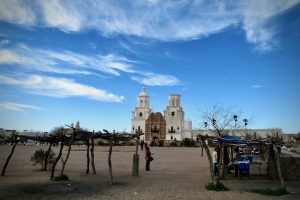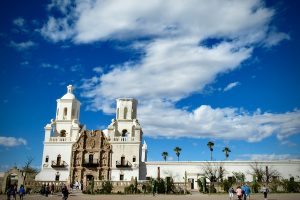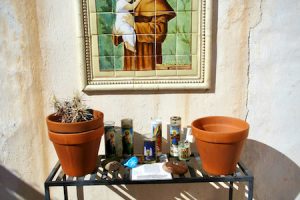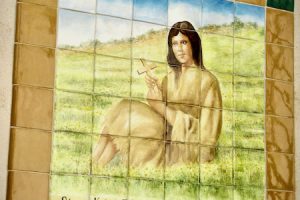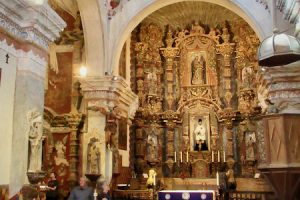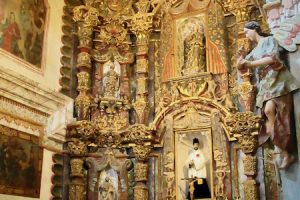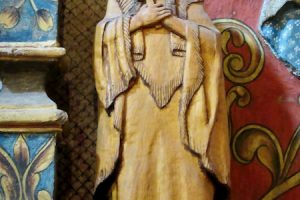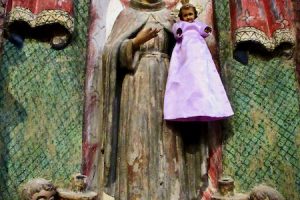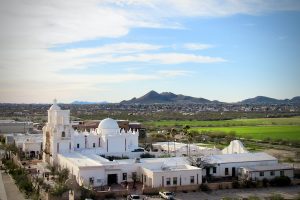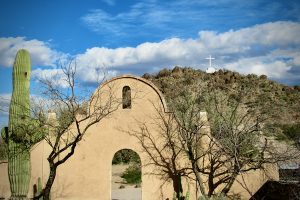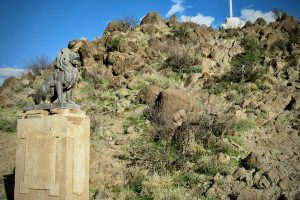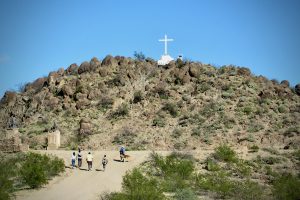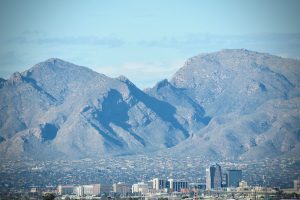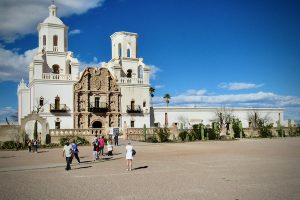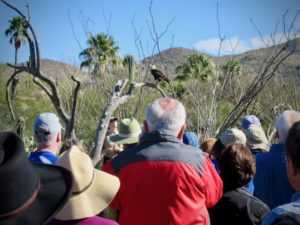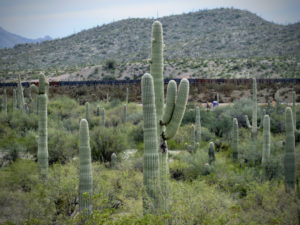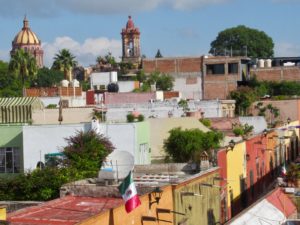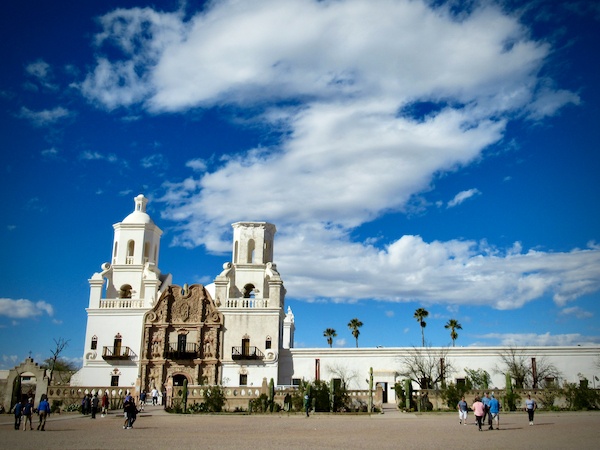
Just 9 miles south of Tucson inside Tohono O’odham Nation sits the oldest European-built structure in Arizona: Mission San Xavier del Bac. Back in the day, this is the northernmost outpost of New Spain (aka Mexico).
Although New Spain’s adventurer/conquistador Francisco Vázquez de Coronado would lead an early expedition through the area from 1540 to 1542, it’s Italy-born Jesuit Eusebio Kino who sets up this more permanent shop in 1687.
Kino wants to go to Asia, but gets assigned to New Spain instead. He makes the best of it, though, because from 1687 to his death in 1711, he takes more than 50 vacations.
These well-documented trips cover anywhere from 100 to 1,000 miles – all on horseback. His travels are immortalized in the epic 1977 film, “Kino: The Padre on Horseback” (aka “The Father Kino Story” aka “Mission to Glory: A True Story”). The film stars Richard Egan and a real Mexican (rather than a Hollywood one), Ricardo Montalban (see “Star Trek II: The Wrath of Khan”).
Father Kino is most likely the first European to visit the Tohono O’odham (which means, literally, “desert peoples”) in the village of Wa:k (“where water emerges”). “Wa:k” is pronounced “Bac” by non-Natives, which is where the “del Bac” comes from in the Mission San Xavier del Bac name.
In case you’re wondering or are not Catholic, Francis Xavier is a co-founder of the Society of Jesus (aka the Jesuits) in Europe and generally regarded as the “best missionary ever!” (he reportedly singlehandedly baptized 1 percent of Japan) – which is how he became a saint. In early 16th century Spain, his buddy and Jesuit co-founder is educator Ignatius of Loyola, who develops the concept of (and becomes the saint of) spiritual retreats. He’s also the patron saint of soldiers. And now you (sort of) know why there are hundreds of institutions worldwide with “Xavier” or “Loyola” in their names. But I digress.
Mission San Xavier del Bac is supposed to be one of the finest examples of the Mexican Baroque style in the United States. I’m still trying to figure out the difference between Spanish Colonial and Mexican Baroque. That particular art history class I took at the College of William & Mary did not stick.
Maybe Linda Ronstadt knows? The iconic singer does the voiceover for “Divine Mission: San Xavier del Bac,” a short video that plays on a loop near the gift shop. It documents the meticulous restoration of the church in recent years.
I was like, “Linda Ronstadt? – that’s odd,” but she was born in Tucson. I knew that she had several Spanish-language albums and, in the 1970s, was in a cover-of-People-Magazine-like relationship with California Governor Jerry Brown, but I did not know she was originally from Arizona. And now I know she dated comedian Jim Carrey and was engaged to Star Wars’ George Lucas for five years. Thanks Wikipedia!
I did not get my architecture answer from Linda, but I did learn a lot on this visit:
- Franciscans are known as the “gray robes,” while Jesuits are the “black robes” – both based on the friars horrific lack of fashion sense.
- The job of the missionary was to “civilize” the locals, and produce loyal new servants to the Spanish Crown. The Indian lifestyle choice of mobility (e.g. seasonal agriculture in the wet summer; hunt and gather in the dry winter) was condemned as “heathen vagabondage,” according to one wall placard.
- From 1700 to 1760, the Spaniards and the O’odham again generally got along. But then silver is discovered in the area, and all hell breaks loose. Funny how a little greed changes everything.
The Apaches burned the original (ca 1700) mission to the ground in a 1770 raid. Two missions were established in 1780. And, again, everyone generally got along for about six months – but then, according to more historical literature on site, the colonists decide to let their livestock destroy Indian crops. They also introduce a new game. Let’s call it “whipping post.”
Well, that didn’t go over well. So there’s another Indian rebellion in 1781. This time, four friars and more than 100 soldiers are killed, and 74 women and children are taken hostage. But those missionaries can be pretty persistent, so they build another church on a new site – the current one – from 1783 to 1797.
Centuries later, in 1946, Linda Ronstadt is born. The mission remains active, serving local parishioners and more than 200,000 visitors each year. And the Tohono O’odham own and operate four Arizona casinos. I think we all know now who got the silver in the end.
If you want to read a dramatic account of the battle between this Mission San Xavier del Bac saguaro spine and my right foot, check out “The Anxiety Arc: 30 Steps to Wellness (Right)” entry in the April edition of the Where’s the Funny? newsletter. And don’t forget to sign up – it’s free!
Timeline of key events:
Native American roots in the southwest go back more than 4,000 years. When the Spaniards arrived to settle this particular area in 1692, there were between 800 and 1,000 O’odham living in the village of Wa:k. Here’s a timeline of key events in the development of Mission San Xavier del Bac:
- 1692: Mission is founded by Father Eusebio Kino, a Jesuit from Padua, Italy, at the O’odham village of Wa:k
- 1700: Kino begins construction of the church north of the present day site
- 1711: Kino dies
- 1756: Father Alonso Espinosa completes the church at the first site
- 1767: Charles III, King of Spain, expels “distrustful” Jesuits from the Americas
- 1768: “More pliable, more reliable” Franciscans arrive from Spain
- 1783: Construction of a new church on the present-day site begins
- 1797: Works ends – technically, the church is unfinished, as you can see most visibly in the incomplete east tower
- 1821: Mexico (aka New Spain) gains its independence from Spain
- 1854: The Gadsden Purchase puts the Mission inside U.S. territory
- 1859: The Santa Fe Diocese begin a series of repairs
- 1887: The Sonora earthquake damages parts of the Mission
- 1906: Bishop Henri Granja begins major repairs and additions, including a convent, the lions on grotto hill and most of the other structures east of the church
- 1939: Lightning strikes the church’s west tower
- 1953: The facade is restored, including a replica pilaster
- 1963: Mission San Xavier del Bac is declared a National Historic Landmark
- 1978: Patronato San Xavier is established to preserve the Mission
- 1989: Water damage requires emergency restoration
- Present: The church continues to serve as a parish for the Tohono O’odham as well as more than 200,000 visitors per year


